Courage is better than skills
From 8þ Kabutoshimen by admin

Courage is more important than skills, if you don’t have courage to use your skills, what’s the point?
The post Courage is better than skills appeared first on 8þ Kabutoshimen.…
From 8þ Kabutoshimen by admin

Courage is more important than skills, if you don’t have courage to use your skills, what’s the point?
The post Courage is better than skills appeared first on 8þ Kabutoshimen.…
From Budoshop by BUDOSHOP.SE
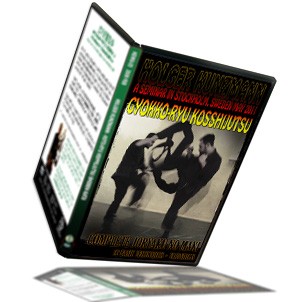
This DVD contains all 12 basic taijutsu techniques from Gyokko-ryu Kosshijutsu Joryaku no maki. They are taught and explained thoroughly as the basic foundation, and with many applications and henka.
Title: Keiko31 – Gyokko-ryu Kosshijutsu Joryaku no maki
Instructors: Holger Kunzmann
Theme: Gyokko-ryu Kosshijutsu Joryaku no maki
Recorded: Recorded in Stockholm April 30th-May 1st 2011
The instruction is in English approximately 120 Minutes playing time.
This DVD contains all 12 basic taijutsu techniques from Gyokko-ryu Kosshijutsu Joryaku no maki. All Taijutsu techniques are taught and explained thoroughly as the basic foundation, and with many applications and henka. The following techniques where taught…
玉虎流 上略の巻 GYOKKŌ-RYŪ JŌ RYAKU NO MAKI
This is the first Taijutsu level in Gyokko-ryu and a very important if you want to learn the Bujinkan Budo Taijutsu system.
1. 虚空 KOKŪ
2. 輦輿 RENYO
3. 弾手 DANSHU
4. 弾指 DANSHI
5. 逆流 GYAKURYŪ
6. 梟鷗 KEO
7. 跳火 HANEBI
8. 闕倒 KETO
9. 指砕 YUBI-KUDAKI
10. 締脈 KETSUMYAKU
11. 殺締 SAKKETSU
12. 蹄拳 TEIKEN
All these techniques are explained and taught in detail. The DVD has menus where you can chose technique to see, completely with chapters.
Extra material from this seminar
We also released an 82 minute video as download file with warm-up and basic Taijutsu training drills. Including extra 20 minutes with henka that we couldn’t fit on this DVD. This is only available as download file, click here for more information
Holger’s main interest in Bujinkan is the basics. And he has become quite famous for his excellent taijutsu and very good knowledge and skill of the basics in Bujinkan.
Holger’s web site… http://www.bkd-reutlingen.de/…
From Budoshop by BUDOSHOP.SE

Lauri, Mariette and Mats are all known and respected Bujinkan teachers in their own country and also internationally. Here they taught individually and together at the end of they day.
Title: Keiko26 – Kukan no Nawa (Taijutsu / Nawa / Kenjutsu /Bojutsu)
Instructors: Lauri Jokinen, Mariette v.d. Vliet, Mats Hjelm
Theme: Kukan no Nawa (Taijutsu / Nawa / Kenjutsu /Bojutsu)
Recorded: Recorded in Stockholm May 1-3th 2009 The instruction is in English
Approximately 120 Minutes playing time.
Lauri from Finland taught Taijutsu with the feeling of rope, both with and without the actual rope.
Mariette from the Netherlands taught Bojutsu against sword, Taijutsu and Self defence against knife attacks.
Mats from Sweden taught Iainuki (drawing the sword), Kenjutsu, Bofuri (spinning with the long staff) and Taijutsu.
Mats Hjelm started training in Bujinkan for the first time around 1983, but it wasn’t until 1986 he had the opportunity to start training more seriously under a Shidôshi. He met Hatsumi Sôke for the first time in 1988. He attends around 20 seminars, go to Japan 2-3 times every year. Since he started training he never had a training break. He takes his budo training very seriously!
Lauri – http:/www.shinden.fi
Mariette – http://www.bujinkanbudokai.nl
Mats – http://www.kesshi.com
If you want to sponsor a seminar or course, please don’t hesitate to contact him. For more information see his web site http://www.kesshi.com…
From Budoshop by BUDOSHOP.SE
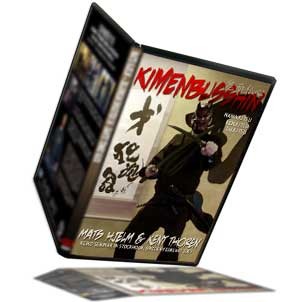
In this video Mats and Kent taught many basic and advanced techniques they did in Japan during January 2009. Taihenjutsu-ukemi unarmed and with a rokushaku-bo (long staff). Taijutsu techniques, and also taijutsu techniques using a rope. And some kenjutsu, sword training.
Title: Keiko24 – Mats Hjelm & Kent T – Taijutsu-Kenjutsu-Nawajutsu (Kimenbusshin)
Instructors: Mats Hjelm & Kent T
Theme: Taijutsu, Kenjutsu, Nawajutsu
Recorded: Recorded in Stockholm February 7-8th 2009 The instruction is in English!
105 Minutes playing time.
Shortly after their Japan trip this year training with Soke and the Shihan, they held this seminar. In this video many basic and advanced techniques is shown.
* Taihenjutsu-ukemi, rolling with or without weapon
* Kenjutsu, sword techniques
* Nawajutsu, using the rope to entangle the opponent
Mats Hjelm started training in Bujinkan for the first time around 1983, but it wasn’t until 1986 he had the opportunity to start training more seriously under a Shidôshi. He met Hatsumi Sôke for the first time in 1988. He attends around 20 seminars, go to Japan 2-3 times every year. Since he started training he never had a training break. He takes his budo training very seriously!
Kent T has been practing Bujinkan Budo Taijutsu for 20 years and is one of the main instructors at Kaigozan Dojo in Stockholm.
If you want to sponsor a seminar or course, please don’t hesitate to contact him. For more information see his web site http://www.kesshi.com…
From Budoshop by BUDOSHOP.SE
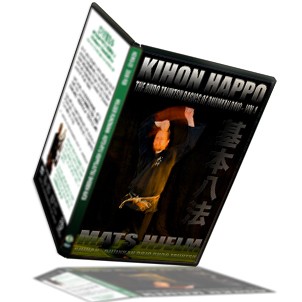
Kihon Happō is the most fundamental and important unarmed fighting techniques in the Bujinkan system.
On video Mats show the basic techniques. Each technique have two ura-waza and many henka. Included is for example Oni-kudaki, Muso-dori, Ō-gyaku and more as ura-waza techniques on this movie.
Please note that Mats added two techniques as ura-waza to each Kihon-happo technique, this is not common practice in the Bujinkan,.. yet?
The techniques in Kihon Happo is…
- ICHIMONJI (+ two ura waza & henka)
- HICHŌ (+ two ura waza & henka)
- JŪMONJI (+ two ura waza & henka)
- OMOTE GYAKU DORI (+ two ura waza & henka)
- OMOTE GYAKU KEN SABAKI (+ two ura waza & henka)
- URA GYAKU DORI (+ two ura waza & henka)
- MUSHA DORI (+ two ura waza & henka)
- GANSEKI NAGE (+ two ura waza & henka)
The video is 100 minutes long. Instruction was in Swedish, but Mats added comments in English to each explanation in the video.
Mats Hjelm started training in Bujinkan for the first time around 1983, but it wasn’t until 1986 he had the opportunity to start training more seriously under a Shidôshi. He met Hatsumi Sôke for the first time in 1988. He attends around 20 seminars, go to Japan 2-3 times every year. Since he started training he never had a training break. He takes his budo training very seriously!
If you want to sponsor a seminar or course, please don’t hesitate to contact him. For more information see his web site http://www.kesshi.com…
From Budoshop by BUDOSHOP.SE
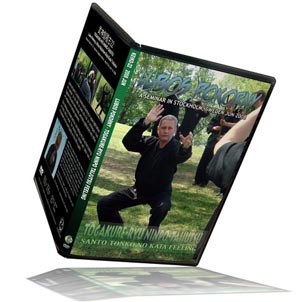
Available as download or full DVD!
Lubos had spent 3 months training and teaching in Japan right before he came for this seminar. On this video he covers the first six techniques from Togakure-ryu Santo Tonko no Kata, and many different applications with different weapons and multiple opponents.
The training was relaxed and fun, the feeling was just as the trainings in Honbu dojo in Japan. It was a beautiful weekend and the training was outside. Lubos had a microphone on so you can hear him very good..
Recorded in Stockholm May 2008
The instructions is in English.

Lubos Pokorny (Shihan 15th Dan Happo Biken) is a student of Dr. Masaaki Hatsumi, the 34th Grandmaster of Togakure Ryu Ninjutsu. As such, he has traveled around the world to take part in Hatsumi Sensei’s training events. During these travels Lubos represents the Czech Republic, beginning his training in 1991, he is the first Czech student of the Bujinkan as well as the founder of the Bujinkan Czech Dojo.
During his stays in Japan, usually 4-5 months per year he also teaches at the Hombu Dojo.
See his web site… bujinkandojo.eu/lubos.php
Click here for more information about our download files and how it works!…
From Budoshop by BUDOSHOP.SE
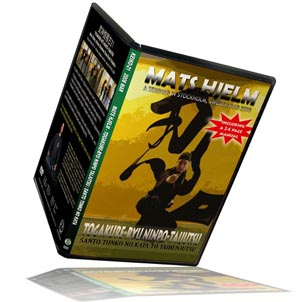
Available as download or full DVD!
This movie contains all 9 techniques from the Togakure-ryû Santo Tonko no Kata. The strategy of the fleeing rat is a collection of 3×3 techniques for quick self defense and then flee away safely.
- 3 Taijutsu techniques (unarmed against one unarmed opponent)
- 3 Muto-dori techniques (unarmed against one swords man)
- 3 Kakushi-buki techniques (hidden weapons against multiple opponents)
Also included on this movie is Sanshin no kata using a hidden knife, plus many taihenjutsu (breakfalling) techniques and training drills.
Included is also a 24 page pdf booklet with the Santo Tonko techniques.
Recorded in Stockholm May 2008
The instructions is in English and there is some subtitles explaining things which is not obvious.
Mats Hjelm started training in Bujinkan for the first time around 1983, but it wasn’t until 1986 he had the opportunity to start training more seriously under a Shidôshi. He attends around 20 seminars, go to Japan 2-3 times every year. Since he started training he never had a training break. He takes his budo training very seriously! If you want to sponsor a seminar or course, please don’t hesitate to contact him. For more information see his web site www.kesshi.com Note!
Click here for more information about our download files and how it works!…
From Budoshop by BUDOSHOP.SE

Available as download or full DVD!
鍛錬 Tanren (training, forging, hardening, drilling) is a set of videos with simple repetitive training drills, do your work out Bujinkan style – SHUT UP AND TRAIN!
This is the second in a series of SHUT UP AND TRAIN videos guaranteed to make you sweat. If you don’t like getting sweaty during training, then this video is not for you. This DVD is for practitioners who want to learn new training drills which might speed up their skill level if really practiced.
It can also be a very good work out that will get you sweaty. Some exercises is easy and some is more difficult, some you can work out on your own and some you need a training partner.
The theme is Sanshin no Kata, and Hiken/Hoken Juroppo. Watch the video to give you some ideas and then SHUT UP AND TRAIN!
Recorded in Stockholm August 2007
The video below is from Tanren-01
http://www.youtube.com/watch?v=WQu_JbAp3Fs
Mats Hjelm started training in Bujinkan for the first time around 1983, but it wasn’t until 1986 he had the opportunity to start training more seriously under a Shidôshi. He attends around 20 seminars, go to Japan 2-3 times every year. Since he started training he never had a training break. He takes his budo training very seriously! If you want to sponsor a seminar or course, please don’t hesitate to contact him. For more information see his web site http://www.kesshi.com
Click here for more information about our download files and how it works!…
From Budoshop by BUDOSHOP.SE
A seminar in Kaigozan Dojo with Shawn Gray from Japan.
This was the 6′th seminar (excl a few Tai Kai and extra trainings) with Mr.Shawn Gray at Kaigozan Dojo in Stockholm Sweden. The theme this time was Gyokko-ryu Kosshijutsu Happobiken, Bojutsu, Ukemi, Sanshin no kata.
Shawn was teaching Taihenjutsu ukemi, breakfalling. Sanshin no kata, five basic movements which can be said to be the roots of Bujinkan Budo Taijutsu, it is also very important basics from Gyokko-ryû. The Gyokko-ryû techniques Kô, Shunu, Shunsoku, Iaifuji was also taught with a lot of variations, both without weapons and also with weapons, mainly the long staff (Gyokko-ryû Bôjutsu). There is also a 30 minute interview with Shawn where he talks about his experience from training in Japan and much more
Recorded in Stockholm, Sweden November 2005
Note: The instructions is in English and there is no sub titles on this VCD
Shawn left behing 10 years of Karate and Kendo to begin Bujinkan training in Canada after returning from a 1-year stay in Japan in 1990. After a training visit in 1995, he relocated to Japan permanently in January of 1997. Shawn passed the godan test in January of 1999, and in 2000 at the urging of Hatsumi sensei established a dojo, the first Bujinkan dojo in Japan led by a civilian foreigner. Shawn has regularly served as interpreter for Dr. Hatsumi and has translated much of Senseis writing into english. He has been regularly invited to give seminars in Europe , North America , and Asia.
More info about Shawn http://bujinkan.graycastle.com
Click here for more information about our download files and how it works!…
From Budoshop by BUDOSHOP.SE
The Tuesday training theme (after Kaigousuru) was Rokushaku Bôjutsu, many variations and ideas on how to defend against someone taking control of your staff and then attacks. Principles and ideas from Gyokko-ryû and this years Bujinkan theme was also covered in detail.
The training was led by Shawn Gray who is a well known and respected instructor in Bujinkan Dojo.
Recorded in Stockholm, Sweden May 2005
Note: The instructions is in English and there is no sub titles on this Video
Click here for more information about our download files and how it works!…